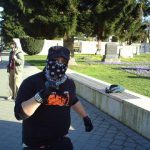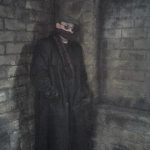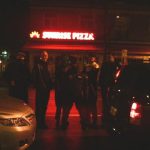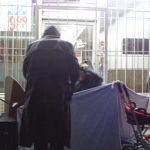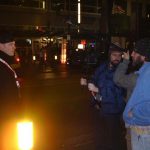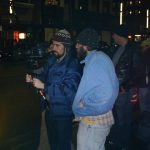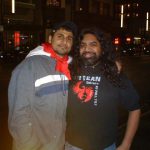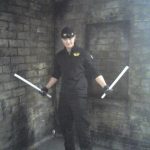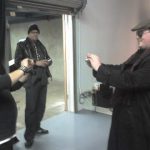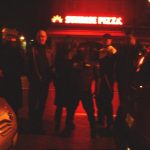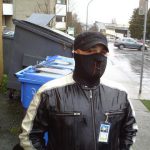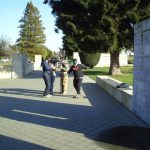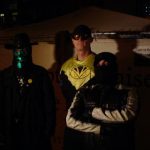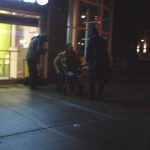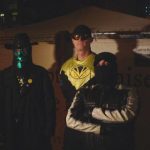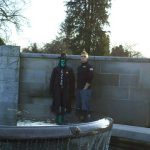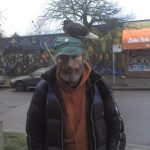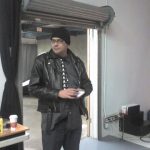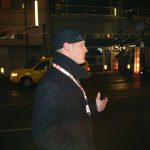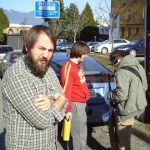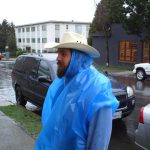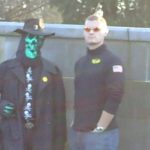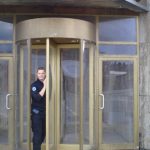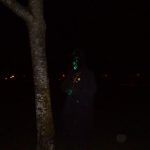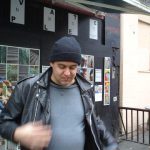Originally posted: http://www.msnbc.msn.com/id/41121744/ns/us_news-giving/#
But Real Life Superheroes don’t have superpowers and most don’t fight crime

Photo by Theodore James
By Jim Gold
Crusaders costumed in tights, capes, cowls and other accoutrements are turning up with surprising regularity in American cities to fight what they consider their biggest enemy: public apathy.
They call themselves superheroes and, with names like Dark Guardian, Red Dragon and Viper, they might be right at home on the pages of comic books. But unlike their ink-and-paper counterparts, they can’t fly, vanish into thin air or outrun a speeding locomotive. And they usually are armed with nothing more than good intentions — and maybe a camera and cell phone.
The Vigilante Spider, who has spent 11 years performing acts of goodness around San Diego, is a member of the Real Life Superheroes. The group has nearly 60 members, who don tights, cloaks and cowls to spread the message that ‘everybody can make a difference.’ Here he’s shown in a new documentary, “Superheroes.”
For the most part, they don’t really fight crime either. Most take on missions to help the homeless, raise money for charity or just lend an ear so someone in trouble knows they care.
“There’s a hero in everybody,” said Dark Guardian, who has patrolled the streets of New York for eight years, resplendent in a blue bulletproof and stab-proof vest with “DG” on the chest. “Everybody can make a difference; we are just a drastic example of what people can do.”
Many costumed do-gooders are loosely aligned under the Real Life Superheroes banner. The group’s website lists nearly 60 members, complete with profiles and portraits. But there appear to be a lot of sidekicks and other prospects waiting in the wings: Nearly 800 contributors participate in its forums, planning meet-ups, exchanging tips on the best gadgets to carry in a utility belt and even consulting an unofficial manual offering guidance on issues such as hero health and legal considerations.
A broken nose for his troubles
A few have crossed the line into real superhero territory — with painful results. That’s what apparently happened to “Phoenix Jones, Guardian of Seattle,” after he became an international media sensation with a run of publicity that included a Jan. 7 appearance on ABC’s “Good Morning America.” A week later, Jones said his nose was broken when he was kicked in the face while trying to break up a street fight between two men, Seattle’s KOMO-TV reported.
The masks and the occasional ventures into real world crime fighting make police understandably nervous.
Masked people at crime scenes is a recipe for disaster, Seattle police Detective Jeff Kappel said, noting that officers often arrive at chaotic scenes where they must quickly sort out suspects from victims and bystanders.
“Put yourself in our shoes,” he said. “… We don’t know who we’re dealing with when we show up.”
And police Lt. Troy Potts of Columbia, Tenn., where police last summer ran off a crusader known as Viper by warning him that he was violating an ordinance barring adults from wearing masks in public, said there are better ways to fight crime.
“Be the best witness you can be,” he said. “Get tag numbers, get a good look at the (criminal’s) face, hair, eye color, tattoos — anything like that will benefit police tremendously.”
A superhero to police would be a person who gives officers a statement and is willing to show up in court later to testify, they said.
But Dark Guardian says cops on the beat aren’t always averse to a small assist.
Routing bad guys with a bullhorn and lights
He said officers didn’t do a thing when he and a dozen others entered New York City’s Washington Square in 2009 with a bullhorn, lights and cameras to confront around 20 drug dealers. One of the bad guys briefly flashed a gun, he said, but the commotion quickly caused the crooks to melt away into the night.
“The cockroaches wanted to get away from their light,” said Peter Tangen, a professional photographer who has followed the crusaders on their rounds for years and whose pictures and interviews are featured on a super hero websitehe runs.
But tense confrontations or physical altercations are “a rare exception” to the costumed crusader rule, said Tangen, who also served as consulting producer on the full-length documentary film “Superheroes,” which debuted last month at the Slamdance film festival in Park City, Utah, and may be released at theaters nationally in July.
“Superheroes” film director Michael Barnett and producer Theodore James followed superheroes on patrol for more than a year.
Barnett said the two thought they might find “eccentric people in costumes” when they started. Instead, they found “courageous, altruistic people,” some with little resources of their own, trying to do something, he said.
“A lot of people feel powerless during stressful times,” Barnett said. “Any little help inspires. That is our film.”
Small victories over evil
Often that help means small victories over evil.
“I don’t go out there with the purpose of beating up bad guys,” said Zetaman, a Portland, Ore., resident who dons a blue-and-black ensemble with a big “Z” emblazoned on his chest before heading out on patrols, which usually entail handing out food, blankets and other supplies to the city’s homeless. “I do stuff that anyone can do.”
The Vigilante Spider of San Diego told the Real Life Super Hero Project that despite his name he relies on bright lights and the element of surprise to stop violence and the spread of graffiti.
It’s difficult to broadly characterize those who disguise themselves to do good. They come from all walks of life, inhabit all sorts of body types and range in age from 6 to over 60. Many share a love of comic books and superhero movies, and a passion for bringing superhero virtues of trustworthiness, bravery, and selflessness to the real world. Some are willing to reveal their real identities, and some agreed to talk if they were identified only by their aliases.

Among them:
- Dark Guardian, otherwise known as Chris Pollak, 26, a martial arts instructor who lives on Staten Island. He said a horrific crime and apathetic bystanders inspired him to don his superhero duds.
The crime was the notorious case of Kitty Genovese, 28, who was sexually assaulted and murdered in a 35-minute attack as she tried to walk from her car to her apartment at 3 a.m., March 13, 1964, in Kew Gardens, Queens, New York. Media accounts, later disputed, said that none of the 38 witnesses to the assault did anything to stop it or called police.
“There’s a hero in everybody,” said Dark Guardian, aka Chris Pollak of Staten Island, N.Y.
Though many members of the Real Life Superheroes were born long after the incident, they are well aware of the story and some, like Mr. Xtreme in San Diego, commemorate the case on their costumes.
“We do not want to let things like that repeat itself,” Dark Guardian said.
- Zetaman (32-year-old Illya King, to his family and friends), who created the Real Life Superheroes website, said his role springs from his desire to make a difference in his community. He described how he and other costumed crusaders recently helped one family of eight they found living on Portland streets.
“They just needed to coast through until the dad got his disability check,” he said, explaining that the family was afraid they’d be split up if they went to a homeless shelter. “We gave them jackets and backpacks so they could hang out at the airport, looking like they were waiting for a flight.”
The family made it through the rough patch and is now living in an apartment, he said.
In an example of his charitable deeds, Zetaman is putting together the Heroic 100 PDX team to participate in a March of Dimes fundraising walkathon called “March for Babies” on April 30 in Portland, Ore
- D.C.’s Guardian, who describes himself as a “Mayberry kind of guy,” referring to the bucolic North Carolina setting of “The Andy Griffith Show” of the 1960s.
D.C.’s Guardian, who does not reveal his real identity but acknowledged he works in national defense, said he brings real life and military experience to his role, which he considers part educational and part inspirational. He can often be found on the Washington, D.C., Mall talking to tourists about the Constitution when he’s not working on behalf of various charities.
As for fighting crime, D.C.’s Guardian said he doesn’t go “looking to get into a situation,” He has, however, called 911 and talked people out of pushing each other around on occasion.

Photo by Peter Tangen
Soundwave, 10, and Jetstorm, 6, are among the youngest real Life Superheroes fighting apathy and trying to inspire people to help others.
- 10-year-old Soundwave and her 6-year-old brother Jetstorm, the youngest superheroes msnbc.com found and who live in the Washington, D.C. area.
Soundwave told msnbc.com that they were inspired by adult crusader D.C.’s Guardian.
“I saw that he was helping people and I wanted to do the same,” said Soundwave, who has been dressing up and doing good deeds for three years.
She also admits to a fondness for the DC Comics character Hawkgirl, who she says shows women can be strong and take care of themselves.
Soundwave raises money for Samaritan’s Purse, a Christian organization providing food and medicine through emergency relief and community development programs.
“Even a penny or two at a time can make a big difference,” she said.
Among other things, she has participated in a cystic fibrosis minimarathon, distributed food to war veterans and handed out information about blood drives, sometimes serving alongside her brother. Soundwave said she considers performing such public service a privilege.
“To be an American means to be free and do whatever you can to help people,” she said.

- Thanatos, 62, probably the oldest member of the Real Life Superheroes. The Vancouver, Canada, resident’s heroic acts mainly involve helping the homeless on gritty Hastings Street.
Thanatos, who is married and has a daughter, says he’s been patrolling for three years, inspired by his youthful readings of comic books — the Green Lantern and Batman were particular favorites — and pulp fiction. He posts videos of his patrols on his YouTube channel.
“I’ve wanted to be a superhero all my life,” he said. “I grew up with comic books, they teach morals, ethics, and the good guy always wins.”
Thanatos says the homeless he encounters in Vancouver, Canada, ‘remember me.’
He said he chose the name Thanatos — a minor figure in Greek mythology who personified “death” — as his persona because street people told him that was all they had to look forward to. His costume consists of a skull mask, gloves, black overcoat, black shirt and pants, crossbones tie, and different forms of body armor, including a bulletproof and stab-resistant vest.
“Some can’t remember their social worker or doctors, but they remember me,” he said. “The costume gets the attention of the homeless and lets them know somebody cares.”
While the Real Life Superheroes acknowledge that, even collectively, their do-gooding can barely scratch the surface when it comes to making a difference in their respective cities, many say they put on their suits in hopes of creating a multiplier effect.
For example, Thanatos told the story of an immigrant couple who ended up on the streets and were afraid to talk to strangers. But when he approached them in his outlandish death-head costume, he said, they were happy to talk.
He then wrote about the encounter in his MySpace blog, which was read by someone who sought them out and gave them jobs.
“It wasn’t just something I did, it was a combination,” he said. “I want to inspire people to say ‘I can do something too.'”
Click here to follow Jim Gold on Facebook.
© 2011 msnbc.com Reprints

